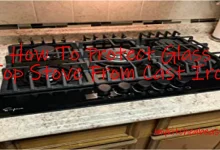How to Protect Glass Top Stove from Cast Iron | Tips and Tricks
People enjoy glass top stoves for their sleek and modern appearance, yet they require extra care compared to traditional stoves. Protecting them from scratches, stains, and other damage is crucial. Glass-top stoves can be sensitive, and materials like cast iron, with its weight, rough bottom, and heat retention, pose a risk of breaking them.
Fear not! With proper tools and techniques, you can safely use cast iron on your glass-top stove without the worry of damage. Let’s explore how to protect your glass-top stove while enjoying the benefits of cooking with cast iron.
How To Protect Glass Top Stove From Cast Iron
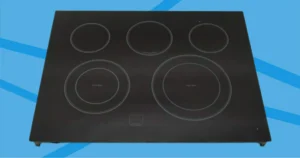
To keep your stove’s glass top safe when using cast iron, follow these simple steps. First, make sure to clean your stove thoroughly before cooking. This prevents dirt or dust from scratching the glass surface. You can also use a silicone mat or a similar item to create a protective barrier between the cast iron and the stovetop.
Remember, always lift your cast iron pots and pans instead of dragging them across the stovetop. This not only protects the glass but also prevents cuts and scratches. Taking these precautions ensures a cleaner and safer cooking experience.
How to Pick the Right Cast Iron Cookware for a Glass Top Stove
To safeguard your glass-top stove and ensure optimal performance, it’s crucial to select suitable cast-iron cookware. Follow these guidelines:
Examine the Cookware’s Bottom
Ensure the cast iron cookware has a smooth, flat bottom with rounded corners. Avoid using pots and pans with rough or uneven bottoms, as they may scratch the stovetop.
Choose Appropriate Size and Weight
Opt for cookware that is not excessively heavy or large for your stove. Heavy pots and pans can create pressure points on the stovetop, while oversized ones may extend beyond the heating elements, leading to uneven cooking.
Prioritize Smooth and Rounded Edges
Select cookware with smooth and rounded edges to prevent any scratches on the stovetop. Sharp or rough edges can potentially damage the glass surface.
Consider Enamel-Coated Cast Iron
For glass top stoves, consider cast iron cookware with an enamel coating. This type of cookware features a smooth, nonreactive surface that won’t scratch or stain the stove. Keep in mind that enamel-coated options may be pricier compared to traditional cast iron cookware.
Remember these tips to not only protect your glass top stove but also to enhance the longevity of your cookware.
How to Stop Pans from Sliding on Glass Top Stoves
Glass top stoves are a popular choice for many kitchens, but they can also be a challenge to use. One of the biggest problems with glass top stoves is that pans can easily slide around, which can be dangerous and frustrating. There are a few things you can do to prevent pans from sliding on a glass top stove, however.
Causes of pans sliding on glass top stoves
There are a few reasons why pans might slide on a glass top stove.
- The pans are too large for the stovetop.
- The stovetop is too hot.
- The pans are made of a slippery material.
How to prevent pans from sliding
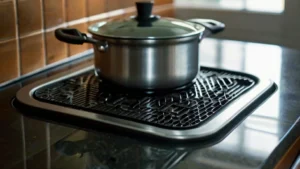
There are a few things you can do to prevent pans from sliding on a glass top stove.
- Use a non-slip mat.
- Place a trivet under the pans.
- Use a potholder to grip the pans.
Materials needed
- Non-slip mat
- Trivet
- Potholder
Steps
- Place a non-slip mat on the stovetop.
- Place a trivet under the pans.
- Use a potholder to grip the pans when you are moving them.
Tips
- Make sure the non-slip mat is large enough to cover the entire stovetop.
- Place the trivet in the center of the pan.
- Use a potholder that is large enough to cover the entire pan.
How to Get Your Glass Top Stove Ready for Cast Iron Cookware
Getting your glass-top stove ready for cast-iron cookware is crucial to prevent any damage. Follow these steps with simplicity in mind:
Clean the Stove Surface
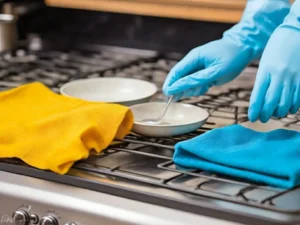
Wipe down the stove surface using a gentle cloth and a cleaner that won’t harm the glass. This helps remove any dirt or dust.
Use a Heat Diffuser
Employ a heat diffuser – a metal plate placed between your pot or pan and the stovetop. This handy tool ensures even heat distribution, preventing hot spots. Additionally, it acts as a barrier to keep your cookware from directly touching the stove.
Place a Protective Layer between the Cookware and Stove
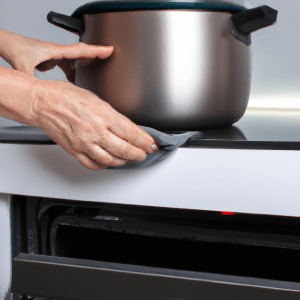
You can prevent scratches and stains by placing a silicone mat, a towel, or a layer of aluminum foil between your cooking utensils and the stove surface. This simple step will help keep your stove looking clean and in good condition.
Prevent Scratching or Harming Your Stove Surface
Raise your pots and pans instead of sliding them to maintain the stove surface in good condition and prevent any scratches or damage.
How To Use Cast Iron Cookware Safely on a Glass Top Stove
Cooking with cast iron on a glass-top stove requires a few adjustments in heat management and cooking methods. Here’s a simple guide to help you:
Gentle Preheating
Prior to cranking up the heat, slowly warm your cast iron pots and pans on low to medium settings for a few minutes. This gradual approach prevents rapid temperature changes that could harm the stove’s surface.
Optimal Heat Settings
Cast iron excels at retaining heat, so there’s no need for high-temperature settings on a glass-top stove. Stick to low to medium heat levels to avoid excessive heat that could potentially damage the stove or cookware.
Avoid Rapid Temperature Shifts
Steer clear of placing cold cast iron cookware onto a hot stove surface or pouring chilly liquids into hot cookware. Such sudden changes can lead to thermal shock, potentially causing damage to the stove.
Lid for Heat Retention
Enhance heat retention and moisture preservation by covering your pot or pan with a lid. This allows you to maintain a consistent temperature without the need to increase the heat setting.
How to Keep Your Glass Top Stove Spotless After Cooking with Cast Iron
Maintaining the cleanliness and longevity of your glass top stove is crucial, especially after using cast iron cookware. Follow these simple steps for effective cleaning and care:
Swiftly Tackle Residue or Stains
Act promptly by using a non-abrasive cleaner and a soft cloth to eliminate any residue or stains on the stove. Swift action prevents them from becoming permanent marks.
Opt for Gentle Cleaners and Tools
Choose non-abrasive cleaners and tools to clean the stove’s surface. Avoid scrubbers or abrasive materials, as they can potentially scratch and damage the glass.
Steer Clear of Harsh Chemicals or Abrasives
Refrain from using harsh chemicals, baking soda, or vinegar on the stove surface. These materials may lead to damage and discoloration over time.
Tackle Tough Stains with Glass Cooktop Cleaner
For stubborn stains, rely on a glass cooktop cleaner designed specifically for glass stoves. Follow the manufacturer’s instructions closely, using a soft cloth or sponge for application.
By adhering to these guidelines, you’ll not only maintain the pristine appearance of your glass top stove but also ensure its durability for years to come.
Will A Cast Iron Skillet Damage A Glass-Top Stove?
If you’re not cautious, using a cast-iron skillet on a glass-top stove might scratch or break the stove’s surface. When placing the cast iron pan on the burner, be sure not to let it slide, as this may result in scratches or even break the glass surface. However, it is feasible to use a cast-iron skillet on a glass-top stove without damaging the skillet surface if handled with care and a silicone mat is employed to safeguard the surface.
What Can You Put On A Glass-Top Stove To Protect It?
Maintaining the sleek appearance of a glass-top stove involves simple yet effective strategies. Use a silicone mat or trivet as a shield between the stove surface and your cooking utensils, providing a protective barrier. Additionally, placing a tempered glass cover over the stove offers protection against scratches and spills. Regularly cleaning the stove with gentle cleaning products prevents surface damage. Finally, when handling pots and pans, lift them off the stove rather than sliding them, as this further safeguards the surface from potential scratches. Following these practices ensures the longevity and cleanliness of your glass-top stove.
What Pans Should Not Be Used On A Glass-Top Stove?
Using a glass-top stove is convenient, but it’s crucial to choose the right pans to protect its surface and ensure good performance. Some pans, like cast iron or stoneware, can potentially scratch or break the glass if not handled carefully. It’s best to be cautious when using these materials. Additionally, pans with warped or uneven bottoms may harm the stove’s surface, so it’s important to opt for those with flat bottoms that sit evenly.
To prevent scratches or cracks, it’s advisable to avoid using pots or pans with rough or textured bottoms. Choosing cookware thoughtfully ensures a smooth cooking experience while keeping your glass-top stove in top condition.
Our Final Thoughts
Using cast iron cookware for cooking has its advantages as it evenly distributes heat and has a long lifespan. However, when using it on a glass-top stove, precautions are necessary to prevent damage. Employ a heat diffuser, gradually heat the pots and pans, and steer clear of abrupt temperature changes to avoid hot spots and scratches on the stove’s surface. To ensure the longevity of a glass-top stove, choose a cleaner that is gentle and won’t scratch the surface. Avoid harsh chemicals and rough materials during cleaning and maintenance. By following these steps, you can safely utilize cast-iron cookware on a glass-top stove without causing any harm or scratches.
FAQs
Why is Cast Iron Bad for Glass Top Stoves?
Using cast iron cookware on glass-top stoves may cause scratches and stains. This happens because the surfaces of these pots and pans are bumpy and not smooth. Moreover, they hold onto heat for a long time, creating hot spots that can harm the stove. To keep your glass stovetop safe, it’s best to avoid using cast iron pots and pans.
Can I Use Enamel-Coated Cast Iron Cookware on a Glass Top Stove?
Absolutely! You can use enamel-coated cast iron cookware on a glass-top stove. The smooth and nonreactive surface of the enamel won’t scratch or stain the stove. It’s a safe and practical choice for cooking on your glass-top stove.
Can I Use a Cast Iron Griddle on a Glass Top Stove?
Yes, You can use a cast iron griddle on a glass top stove, but it’s essential to take precautions to avoid damaging the glass. To ensure safety and prevent any potential breakage, employ a heat diffuser and refrain from moving the griddle around on the stovetop. This will help you enjoy the benefits of using a cast iron griddle without risking harm to your glass surface.
